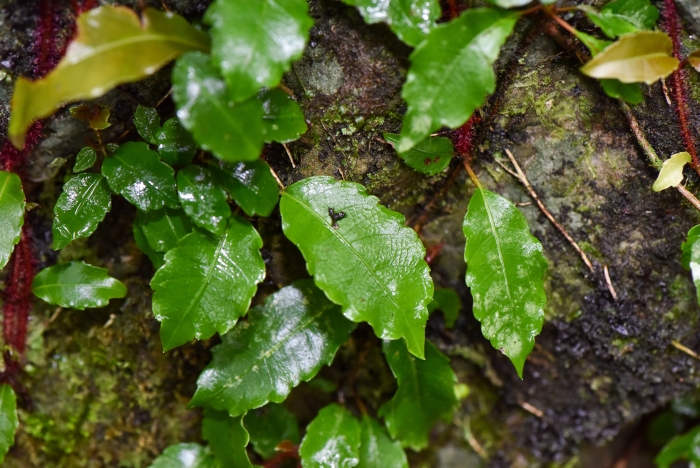Evergreen Climbing Hydrangea
(Hydrangea integrifolia)
Evergreen Climbing Hydrangea (Hydrangea integrifolia)
/
/

Cheng-Tao Lin
CC BY 4.0
Image By:
Cheng-Tao Lin
Recorded By:
Copyright:
CC BY 4.0
Copyright Notice:
Photo by: Cheng-Tao Lin | License Type: CC BY 4.0 | License URL: http://creativecommons.org/licenses/by/4.0/ | Rights Holder: Cheng-Tao Lin | Publisher: iNaturalist | Date Created: 2020-04-25T10:13:08-07:00 |






























Estimated Native Range
Summary
Hydrangea integrifolia, commonly known as Evergreen Climbing Hydrangea, is an evergreen perennial vine native to the forest margins and rocky areas of the Philippines and Taiwan. It can reach a mature size of 30 to 40 feet tall when supported. The vine climbs using adventitious roots, which cling to surfaces without the need for additional support. The leaves are approximately 6 inches long, dark green, glossy, and have a leathery texture. Their shape is elongated and ovate with undulating and toothed margins. Flower buds are unique, resembling oversized golf balls before opening. Blooms appear around June, forming terminal cymes with numerous small, white flowers in a lace-cap arrangement, typically without the sterile blooms found on the edges of other Hydrangea species. Spent blooms dry on the plant and persist through the season, while fruits are dry, brown capsules.
Evergreen Climbing Hydrangea is valued for its ornamental foliage and flowers, which add vertical interest and a layer of texture to shaded garden areas. It is particularly useful for covering walls, trellises, or trees, providing year-round greenery. This vine is salt and shade tolerant, although too much shade can diminish blooming. It requires regular watering, well-drained soil, and sturdy supports. Full sun to partial or dappled shade is ideal. It is a slow grower, taking 5 to 7 years to mature and bloom, but it is not invasive. Best suited to milder climates, it thrives in USDA hardiness zones 8a to 10b. Pruning is minimal, mainly for shaping and deadheading. Propagation is possible through cuttings and seeds.CC BY-SA 4.0
Evergreen Climbing Hydrangea is valued for its ornamental foliage and flowers, which add vertical interest and a layer of texture to shaded garden areas. It is particularly useful for covering walls, trellises, or trees, providing year-round greenery. This vine is salt and shade tolerant, although too much shade can diminish blooming. It requires regular watering, well-drained soil, and sturdy supports. Full sun to partial or dappled shade is ideal. It is a slow grower, taking 5 to 7 years to mature and bloom, but it is not invasive. Best suited to milder climates, it thrives in USDA hardiness zones 8a to 10b. Pruning is minimal, mainly for shaping and deadheading. Propagation is possible through cuttings and seeds.CC BY-SA 4.0
Plant Description
- Plant Type: Vine
- Height: 25-30 feet
- Width: 15-20 feet
- Growth Rate: Slow
- Flower Color: White
- Flowering Season: Summer
- Leaf Retention: Evergreen
Growth Requirements
- Sun: Full Sun, Part Shade
- Water: Medium
- Drainage: Fast
Common Uses
Bee Garden, Butterfly Garden, Low Maintenance, Rabbit Resistant, Showy Flowers
Natural Habitat
Forest margins and rocky areas of the Philippines and Taiwan
Other Names
Common Names: Quan Yuan Xiu Qiu
Scientific Names: , Hydrangea integrifolia, Hydrangea integra, Hydrangea cuneatifolia, Hydrangea glandulosa, Hydrangea subintegra, Cornidia integrifolia,
GBIF Accepted Name: Hydrangea integrifolia Hayata